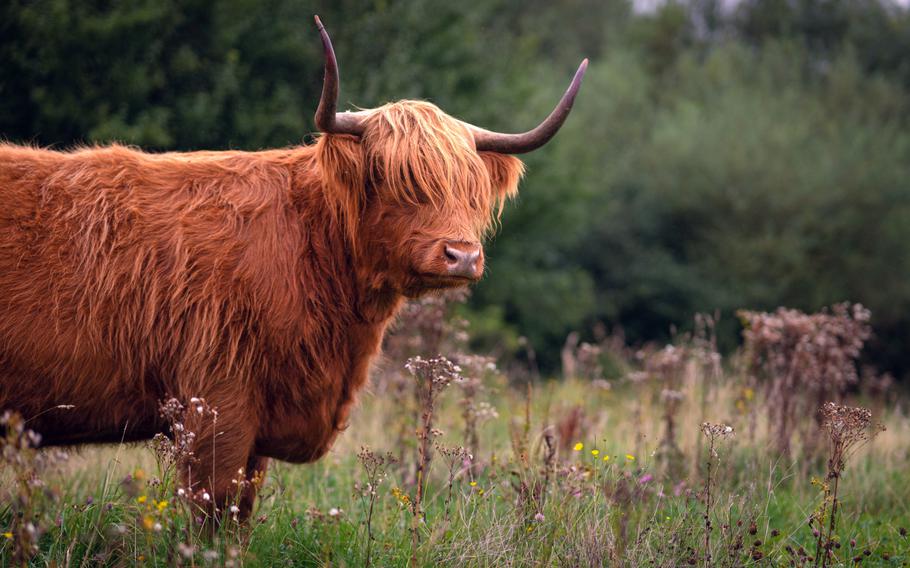
A cute, shaggy brown highland cow with big horns standing in a meadow surrounded by dark trees (Wirestock)
I’m a little late to the New Year’s resolutions rush for 2025. But in case some of you are still pondering which rules to embrace and which pleasures to forgo in the name of a higher purpose, I want to put an unorthodox option on the table: To save the world from climate change, stop eating organic. That is, if you truly think the world is on the verge of a climate catastrophe, cut the grass-fed, free-range, hormone-free, happy-cow steak.
Admittedly, it would be better for the environment if the world went off steak (and lamb) altogether. Doing so would cut down on the methane belches while curbing one of the main causes of deforestation, which itself releases tons of carbon dioxide into the atmosphere. Beef production generates 310 kilograms of carbon dioxide per kilo of protein — on average seven times as much as chicken.
But ending beef consumption won’t happen anytime soon. There is a lot of pent-up demand for meat, with vast populations that have never had a bite. If the denizens of Brooklyn, Berkeley and other enlightened spots around the world all slashed their beef intake, plenty of people in less-advantaged places would welcome the falling prices as an opportunity to order steak.
A second-best solution, then, would be to let go of the idyllic image of a family farm we all have somewhere in our mind’s eye — of a denim-clad farmer walking from a barn to a pasture, calling out the names of his pampered cows. We need to instead embrace the reality that this guy’s operation does more damage to the climate per pound of beef than corporate farms do. Factory farms where cows don’t have names and are grown much faster, fattened in feedlots with no pastures in sight, are better for the environment.
Grass-fed cows grow more slowly than those fattened with grain, burping methane the whole time. Moreover, organic feed also requires more land to produce, further encouraging deforestation. An evaluation by the World Resources Institute of multiple studies on the carbon impact of farming concluded that grass-fed, organic and free-range meat and dairy production systems used more land per gram of protein 90% of the time and emitted more greenhouse gases in 70% of the cases.
There are, to be sure, other reasons to prefer organic meat. Corporate cows get fed a lot more antibiotics. If most of us ate grass-fed animals instead, antimicrobial resistance might not be as much of a problem. Still, in terms of impact on the climate, land use trumps every other consideration: Feeding billions of people on organic meat and vegetables would require a massive expansion of agriculture’s footprint.
This is not merely a beef about beef, by the way. The thought applies to all of our food. Indeed, agriculture accounts for over 25% of all greenhouse gas emissions. And deforestation, which converts native forests critical to sequestering carbon from the air into pasture and cropland, is a big part of this. According to the U.N.’s Food and Agriculture Organization, 38% of the world’s land is devoted to agriculture. About one-third of this is devoted to cropland and two-thirds to pastures and meadows for livestock.
The orthodox disgust for Big Ag and its industrialized, fertilizer- and herbicide-heavy approach to food somehow ignores how effective it has been at reducing the impact of food production on natural ecosystems. In 1961, 0.45 hectares were devoted to cropland for each person on the planet. By 2016 that had come down to 0.21 hectares, according to the FAO.
But a growing world population must be fed. According to a new study, as the world’s population expanded by 21%, to 7.7 billion, the world’s cropland area expanded by 9% from 2003 to 2019, to 1.24 billion hectares. And the rate of expansion has accelerated sharply over the past two decades. Research by WRI found that based on current trends, land twice the size of India will be converted for agriculture between 2010 and 2050. The world desperately needs to produce more food on less land.
There are a variety of things that can be done to take pressure off the land, from reducing food waste to eating less meat and growing fewer biofuels. But reviving the family farm is not among them. Agriculture needs more science — more high-tech crops, fertilizers and herbicides. It needs more genetic engineering, not less.
Eduardo Porter is an editorial writer and columnist at The Washington Post. He formerly worked at The New York Times, The Wall Street Journal, Bloomberg Opinion and Notimex. He is the author of “American Poison” and “The Price of Everything.”